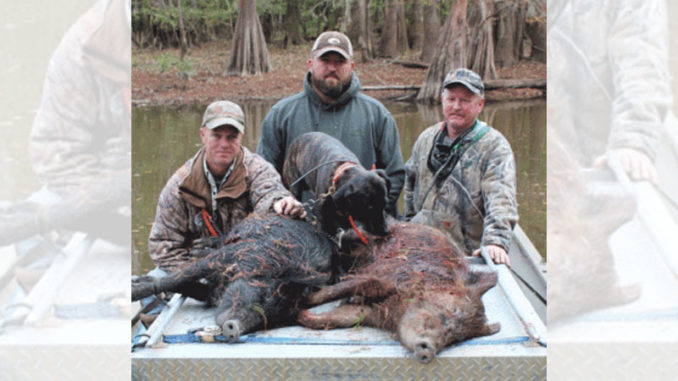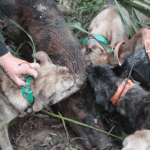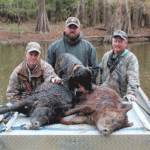
Hunting wild hogs with a pack of dogs is a great way to spend a winter day.
A low growl emanated from a cluster of wild hogs backed into a circle, butt-to-butt, facing six dogs that had found them napping on a cold January morning. The dogs cautiously stood their ground, trying to determine which hog was most vulnerable. The hogs calculated their best escape plan, ready to do battle if it came to that.
A fog of hot breath filled the air as Borden’s Todd Dillon raised a handgun skyward and quickly warned, “When I pull this trigger, there’s going to be hogs and dogs going everywhere. If we’re lucky, the dogs will pin one hog down in the process.”
With the report of the handgun, hogs and dogs did, indeed, go everywhere, along with mud, dried leaves and even full-grown shrubs. A few big boars of 350-plus pounds with long, sharp tusks were in the group. The dogs, most of which were 25- to 40-pound Catahoula curs, knew better than to attack any of those beasts individually. But as one of the smaller hogs slipped in the mud, two of the dogs shook off the shock of the gunshot and teamed up on the swine.
That’s when Sumter’s Mikey Colboth released Shug, the “catch dog” from her leash. A minute later, with the three dogs having control of the hog’s head, Dillon grabbed the hog by the back legs as Rembert’s Chris Warren pushed an 8-inch knife blade into the hog’s heart. Within seconds, the hog was dead.
“That’s the quickest, safest and most-humane way to kill a hog, right there,” said Dillon, pointing out the area just above the sow’s front knee joint as Colboth and Warren shooed the dogs off the expired hog.
Catch dogs need to be restrained until the right time
“We have to keep Shug on the leash until a couple of dogs are on a hog. The bay dogs know when it’s safe to clamp down on a hog. Shug, though, she’s not afraid of anything. So she’ll jump in there before it’s safe. That’s why she’s cut up so,” said Warren, reaching under Shug’s protective vest to show the scars from the dog’s previous encounters with long-tusked boars. “But once she clamps on, that hog’s not getting away. It might drag her, but she won’t let loose.”
That’s why, according to Dillon, it’s important to always approach a hog from the rear, preferably on the side of the catch dog.
“If that hog gets a chance to swing its head around, you want the dog with the protective vest between you and those tusks,” he said.
Looking for tusks on the harvested hog, Warren peeled back the lips, showing very slight ones.
“This one’s a sow, and they don’t grow big tusks,” he said. “A boar this size would have some stout tusks. She’ll go about 220 pounds. She’s going to be fun getting back to the boat.”
Dillon, Colboth and Warren hunt hogs with dogs at least once a week, with most of their hunts taking place between the public lands of Sparkleberry Swamp and private hunt clubs and farmland in Sumter County. While some hog-doggers run what are known as “open-mouthed dogs,” this trio prefers closed-mouth, or silent dogs.
“Our dogs don’t bark or make any noise as they look for hogs. They just sniff them out, surround them and clamp down when the time is right,” said Dillon. “This allows them to sneak up on hogs without alerting them. And it keeps chase times way down. It’s less stress on the animals and on us.”
GPS units help in many ways
Warren marked the sow on his GPS for retrieval later, then urged the dogs to hunt up another one. As they began hunting again, Dillon explained how the dogs work.
“They’ll run out about 100 yards, then circle back to check in. Then they’ll run out about 200 yards before coming back. They’ll stretch out a little more each time. If they don’t come back for a while, you know they’ve got a hog bayed,” he said. “But with Chris’s GPS, we’ll know it when it shows all the dogs stopped together in one location.”
Each dog has its own tracking collar, and each one is linked to Warren’s GPS, showing in real time every dog’s location. Within an hour of killing the first hog, the hunters began noticing cypress trees with mud rubbed all over their bases. It’s a tell-tale sign of hogs, which rub against these trees as they make their way through the swamp after wallowing in the mud. Looking at his GPS, Warren said, “They’ve got another one bayed 280 yards ahead.”
This was a much smaller sow — about 110 pounds, and unlike the first one, it was all alone. Colboth dispatched this one in the same manner Warren used earlier. While some hunters use long guns or handguns, these hunters use only knives when hog hunting.
“It’s just not safe to shoot with all these dogs around,” Dillon said.
Boats are also important hog-hunting tools
They started the hunt at Pack’s Landing, where they launched the boat. And after an hour’s ride, they parked on an island and loosed the dogs. That’s a typical start to a swamp hunt. But a boat isn’t always involved. Dillon, Colboth and Warren also hunt area farms. Other than leaving the boat out of the picture, those hunts are pretty much the same as this one.
According to Warren, using dogs lessens the impact of many factors that can decrease a hunter’s chances at success when rifle-hunting from a stand. The moon phase, the weather and even the time of day really don’t matter at all when letting the dogs do the work.
“On a full moon, the dogs will just find hogs sleeping later. But that doesn’t hurt our chances at success,” he said. “If hogs are in the area, the dogs will find them.”
Hunters do need to take some precautions, however, when hunting hogs with dogs. One is relative silence while walking through the woods. Dillon said hogs are used to noise and don’t mind hearing the crunching of leaves that dogs and people make while walking. But they will disappear if they hear a human voice — usually before the hunters even know they are there.
Find food, water, and cover, and you’ll find hogs
“Some people hunt long-range dogs, and noise isn’t a big factor when your dogs are 1,500 yards ahead of you. But our dogs hunt much closer than that. A human voice will spoil one of our hunts before it even gets started,” Dillon said.
Hogs also have a very keen sense of smell — as good as, if not better than, whitetail deer, according to Dillon.
“You want the wind in your face and in your dogs’ faces because hogs can smell as well as any animal in the woods,” he said.
Outdoorsmen should look for three key items to find likely places to hunt hogs: a water source, food and cover. Hogs are smart enough to find natural water sources even when they’re scarce.
“We’ve hunted hogs in cornfields during droughts. They’ll find a field with irrigation systems which create puddles of water, and they’ll lay amongst the corn stalks in the middle of a huge cornfield all day, just standing up to eat corn, then wallow in the mud puddles to beat the heat. They barely have to move to have all their essentials met,” Dillon said.
Find those three essentials in one area, and you’re well on your way to harvesting your own wild hogs.






Be the first to comment